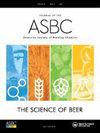新型谷物Kernza (Thinopyrum intermedium)的酿造及麦汁生产潜力
IF 1.8
4区 农林科学
Q4 BIOTECHNOLOGY & APPLIED MICROBIOLOGY
Journal of the American Society of Brewing Chemists
Pub Date : 2022-03-16
DOI:10.1080/03610470.2022.2026662
引用次数: 3
摘要
随着啤酒对环境的影响越来越受到酿酒师、酿酒商和消费者的关注,多年生谷物作物可以提供一个更可持续的解决方案。酿造工业感兴趣的一种新的谷物是中间小麦草(Thinopyrum intermedium subsp)。intermedium),由美国堪萨斯州萨利纳的土地研究所开发,品牌为Kernza®。它被吹捧为大麦和小麦更可持续的替代品,因为它需要更少的水和营养补充,减少了农田的耕作。到目前为止,还没有发表的研究来评估这种谷物作为大麦替代品在麦芽和啤酒工业中的潜力。在这里,“M5”品种Kernza谷物被微麦芽化,成品麦芽与原料谷物和参考原料和麦芽(Hordeum vulgare L. var. Copeland)进行比较。通过差示扫描量热法分析所有样品的淀粉糊化温度、氨基酸组成、α -淀粉酶、散散力(DP)、总氮和可溶性氮和蛋白质、科尔巴赫指数(KI)、提取物、麦汁游离α -氨基氮(FAN)、麦汁β-葡聚糖、麦汁颜色、pH和透明度。对于典型的β-葡聚糖含量低的发酵,克恩扎麦芽产生了足够的提取物和FAN。然而,克恩扎麦芽的提取物和FAN含量低于参考大麦,克恩扎麦芽表现出更高水平的不良可溶性蛋白和雾度。有趣的是,生的和麦芽的Kernza的DP都同样高,这表明两种生谷物都表现出很高的酶活性,而麦芽并没有显著增加。结果表明,Kernza可以作为麦芽和后续麦汁生产的可接受的候选品种;然而,为了最有效地利用这种麦芽,可能需要特定的技术。本文的补充数据可在https://doi.org/10.1080/03610470.2022.2026662上在线获得。本文章由计算机程序翻译,如有差异,请以英文原文为准。
Malting and Wort Production Potential of the Novel Grain Kernza (Thinopyrum intermedium)
Abstract As the environmental impacts of beer are of increasing concern to maltsters, brewers, and consumers, perennial cereal crops can offer a more sustainable solution. One new cereal species of interest to the brewing industry is intermediate wheatgrass (Thinopyrum intermedium subsp. intermedium), developed by The Land Institute, in Salina, Kansas, U.S.A., under the branded name Kernza®. It has been touted as a more sustainable alternative to barley and wheat in its requirements for less water and nutrient additions and reduced tilling of agricultural fields. To date, no published research has been performed to assess the potential for this grain for the malt and beer industries as a barley replacement. Here, the “M5” variety Kernza grain was micromalted and the finished malt was compared with both the raw grain and to a reference raw and malted barley (Hordeum vulgare L. var. Copeland). All samples were analyzed for starch gelatinization temperatures via differential scanning calorimetry, amino acid composition, alpha-amylase, diastatic power (DP), total and soluble nitrogen and protein, Kolbach Index (KI), extract, wort free alpha-amino nitrogen (FAN), wort β-glucan, wort color, pH, and clarity. The Kernza malt produced sufficient extract and FAN for typical fermentations with low β-glucan content. However, extract and FAN in the Kernza malts were lower than in the barley reference, and the Kernza worts exhibited higher levels of undesirable soluble protein and haze. Interestingly, the DP for both the raw and malted Kernza were similarly high, indicating that both of the raw grains exhibit high enzymatic activity, which malting did not increase substantially. Results support that Kernza could be an acceptable candidate for malting and subsequent wort production; however, specific techniques may be required to utilize this malt most effectively. Supplemental data for this article is available online at https://doi.org/10.1080/03610470.2022.2026662 .
求助全文
通过发布文献求助,成功后即可免费获取论文全文。
去求助
来源期刊

Journal of the American Society of Brewing Chemists
工程技术-生物工程与应用微生物
CiteScore
4.00
自引率
20.00%
发文量
41
审稿时长
3 months
期刊介绍:
The Journal of the American Society of Brewing Chemists publishes scientific papers, review articles, and technical reports pertaining to the chemistry, microbiology, and technology of brewing and distilling, as well as the analytical techniques used in the malting, brewing, and distilling industries.
 求助内容:
求助内容: 应助结果提醒方式:
应助结果提醒方式:


